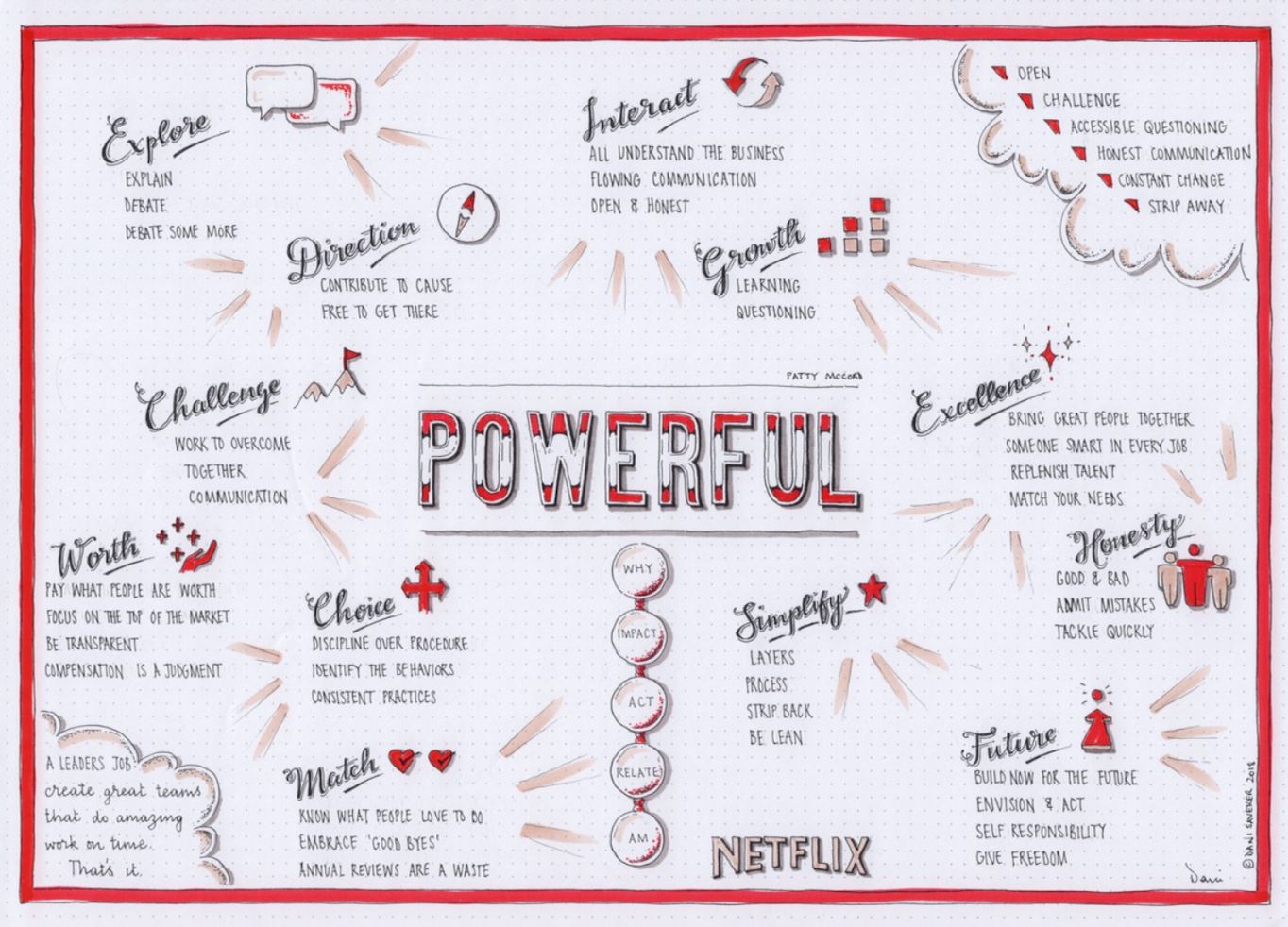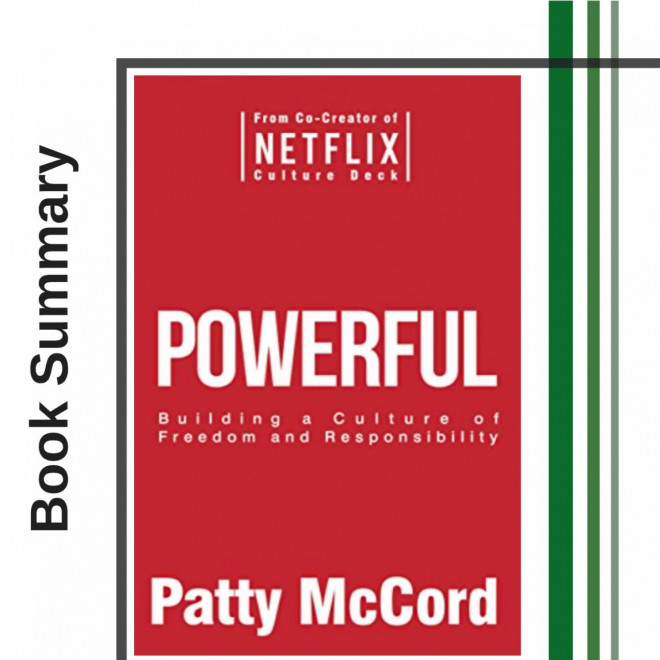- How should we treat employees?
- Why is it worth learning from athletes?
- How to recruit employees?
- How to create conditions for innovation?
- How to turn theories into practice?
- How to overcome your reluctance to change?
- Why are openness and communication important?
- What's the secret to Netflix's success?
- A piece of history, not just the culture of the organization.
- Manager = Recruiter.
- Fruity Thursdays, Fridays, and Saturdays.
- Forks, oh those forks.
- An admirable structure.
- A book, not for everyone.
One of the coolest books on organizational culture I have read. If Patty's name doesn't mean anything to you, I would like to add that she is behind Netflix's HR success and culture. In eight chapters, McCord discusses the pillars that makeup Netflix's DNA as an employer. He writes that the key to the company's business success is understanding business goals by all employees (without exceptions) and openness to their questions and doubts. It points out how much value it can be to encourage employees to make mistakes and learn from their actions. It emphasizes the importance of transparency within the organization and compares internal communication to arteries. Internal communication, providing employees with all the necessary information about the company, protects the company's life, just like arteries pumping blood to the human heart.
How should we treat employees?
Patty's bottom line is: start treating employees like adults, and then fantastic results will emerge. People come to work as fully-fledged adults, eager to impact and proud of what they do.
- Let's give people their own freedom of action. Then regulations, rules, and all bureaucracy will become redundant.
Patty challenges the standards in force in organizations and HR departments and encourages rethinking their validity. He does not like corporate phrases such as best practices or empowerment.
Family is a frequently used and even overused metaphor for a company. In her opinion, this is a harmful fiction. A business is a business, and a family is a family. The company is teamwork what we do when we work together. Using this metaphor, we must also accept all the bad things that happen in the family. -
Today, thanks to work by Zoom, I can see other real family members as well as cats. Family is a different type of relationship than work.
Why is it worth learning from athletes?
How to recruit employees?
Traditional ads don't make sense. You should change your approach to recruiting by focusing on your goal as a leader. Write in the advertisement what problem you want to solve. What type of person is to solve it and at what time. Describing the features of a future employee is not enough. He will be intelligent, but it is not enough when he does not have the new competencies needed to solve the problem. Things don't move forward when everyone knows the same thing.
Advice for the leader:
- As a leader, never let your chance pass over you because you don't have the right team to use it. A manager's role is to choose a team to win by creating such experience and conditions for people to do their best work.
At the same time, the company should not make false promises about work safety. If a good employee no longer fulfills the role that is needed, he must leave. This was the situation that Netflix faced when it became a movie streaming platform. The IT department needed new competencies and new people with knowledge of cloud technologies.
How to create conditions for innovation?
Patty's secret advice:
- Get rid of something! If you really want to change the organization, create a place where you remove obstacles blocking action. - I mean everything! I got rid of a lot of things: time control, approvals for financial expenses for travel. Instead, I gave a set of tips: act in a way that is in the company's best interest. Spend money as if it were yours.
People, not convinced whether they understood her words well, came and asked what the company's policy was regarding A, B, C.
- Think about what an adult would do in this situation. Refer to your common sense. Did you spend $ 700 on lunch with a customer just because he likes good wine? This is probably not the best solution.
Patty also hates annual summaries and performance evaluations and other nonsense such as anonymous employee surveys and payroll secrecy. In her opinion, bureaucracy slows down innovation.
- Annual employee appraisal is a waste of time. In return, it's better to give real feedback. Concrete applicable solutions to improve efficiency and make the team successful. Sports coaches can do this.
How to turn theories into practice?
Her approach meets with understandable skepticism. "It's a great idea, Patty, but we can't." We're in Europe, not California. We are a bank, and we are subject to the rules. We are a company with traditions, and we have always done this. We can not! We can not! We can not!
Patty responds to doubts by referring to the example of remote work, where today millions of people, entire companies, work from home. It literally took us a moment to figure out how to work from home. People are doing their job, and we don't have to check them! Flexible work is the trend. I wish this were a megatrend.
Patty appeals to our courage not to go back to the beaten track. Each of us has the ability to change. What you do doesn't have to be the same over and over again. Example: Instead of showing a 100-slide presentation when you do something, do it. He believes in a world where we trust each other; we will work faster and get things done more efficiently.
How to overcome your reluctance to change?
Often, the HR department stands in the way of changes. How to change it?
People will work better when they understand your business perfectly. But it is equally important for managers to be aware of their people's work. During a meeting with 700 managers in Silicon Valley, everyone raised their hands when recruiting programmers. After asking who sat with them to see how they were working in the room, there was consternation. - Show what you expect, and you will be surprised by the results.
Why are openness and communication important?
Employees behave completely differently when they know how the company works and in what situation it is. This is where there is room for sincere communication and mutual trust. When each employee knows the difference between income and profit, how many customers the company has, and what it earns.
- At Netflix, everyone had to read the company's profit and loss account. In a word, when people know how the company works and what the situation is, they will not be surprised when layoffs come. On the contrary, they maintain dignity. When Netflix once had to lay off a third of the team, everyone was regularly informed about the financial situation.
- Yes, it was not without tears, but such an approach made sense. People hate being lied to.
What's the secret to Netflix's success?
- Treat people like adults. Please encourage them to speak up and discuss honestly. They can be taught that, Patty concludes.
A piece of history, not just the culture of the organization.
There is history from the very first pages. I love stories; they allow us to understand better and be part of the experience. The book is not only a listing of the individual parts that make up the company's culture. These first chapters are a real insight into our heroine's character, her attitude towards people, employees, work, and the company itself. The history of Netflix before it was a streaming platform and competed with Blockbuster. Do you still remember Blockbuster? Interesting times huh? I wonder what made Blockbuster currently have one (yes, you read it, one) stationary point worldwide, and Netflix is one of the fastest-growing companies in the world.
Manager = Recruiter.
Why is this not a standard? Why are team leaders not qualified as recruiters? This is one of the clearest examples of Netflix's practices that are dramatically impacting their organizational culture. Managers of individual teams are responsible for hiring people for the company. It is in their role to conduct recruitment. People from the HR department support the process while the manager looks for candidates, conducts recruitment interviews, and hires his team. Responsibility rests on his shoulders.
Fruity Thursdays, Fridays, and Saturdays.
Isn't it a bit like with them that everyone wants them, but deep down, we all hate them? Deep down, we know that they are just makeup meant to cover up the dark circles under the eyes of the organization in many cases. Decent pay is the basis, but the real benefit for talented and committed people (and we want to employ such people) will always be challenges. I share that view of Patty McCord. If we treat the people we want to employ as serious and ambitious specialists, fruit Fridays or Mondays do not count. What really matters is what drives people at work. Satisfaction with overcoming barriers, the feeling of achieving something seemingly unattainable, or working with brilliant specialists who bring out the best in each other. Should we donate fruit at the office and multisport cards? YES! If you pay adults decent money, they will be able to buy fruit for themselves.
Forks, oh those forks.
I have to admit that this book's salary topic could be a spoonful of tar in this keg of honey for many readers. We are talking here about the strategy offered to candidates and whether and when to disclose the spreads. More and more (especially in IT) is being said about disclosing the spreads already at the recruitment announcement stage.
An admirable structure.
The last (not generally listed) but an important advantage of this position. I was very impressed by the very structure of information in the book. Usually, chapters devoted to one area end with two sections. In a nutshell and Considerations. This makes it easier for the reader to remember what he has just read and increases the probability and ease of introducing the changes suggested in the book. This makes the book appear to be a combination of a novel and a professional textbook.
A book, not for everyone.
This is not a book written by an HR specialist for HR specialists. This is a book written by a brilliant manager for HR professionals, business owners, managers, and everyone involved in their work. However, you must approach it with an open mind and a critical look at your current activities. If you've gotten too used to Fruit Tuesdays or think money isn't the most important thing, then don't read this book.

Picture was taken from (Visual Synopsis by Dani Saveker)


 Posted on Mar 1, 2021 by Anna
Posted on Mar 1, 2021 by Anna


